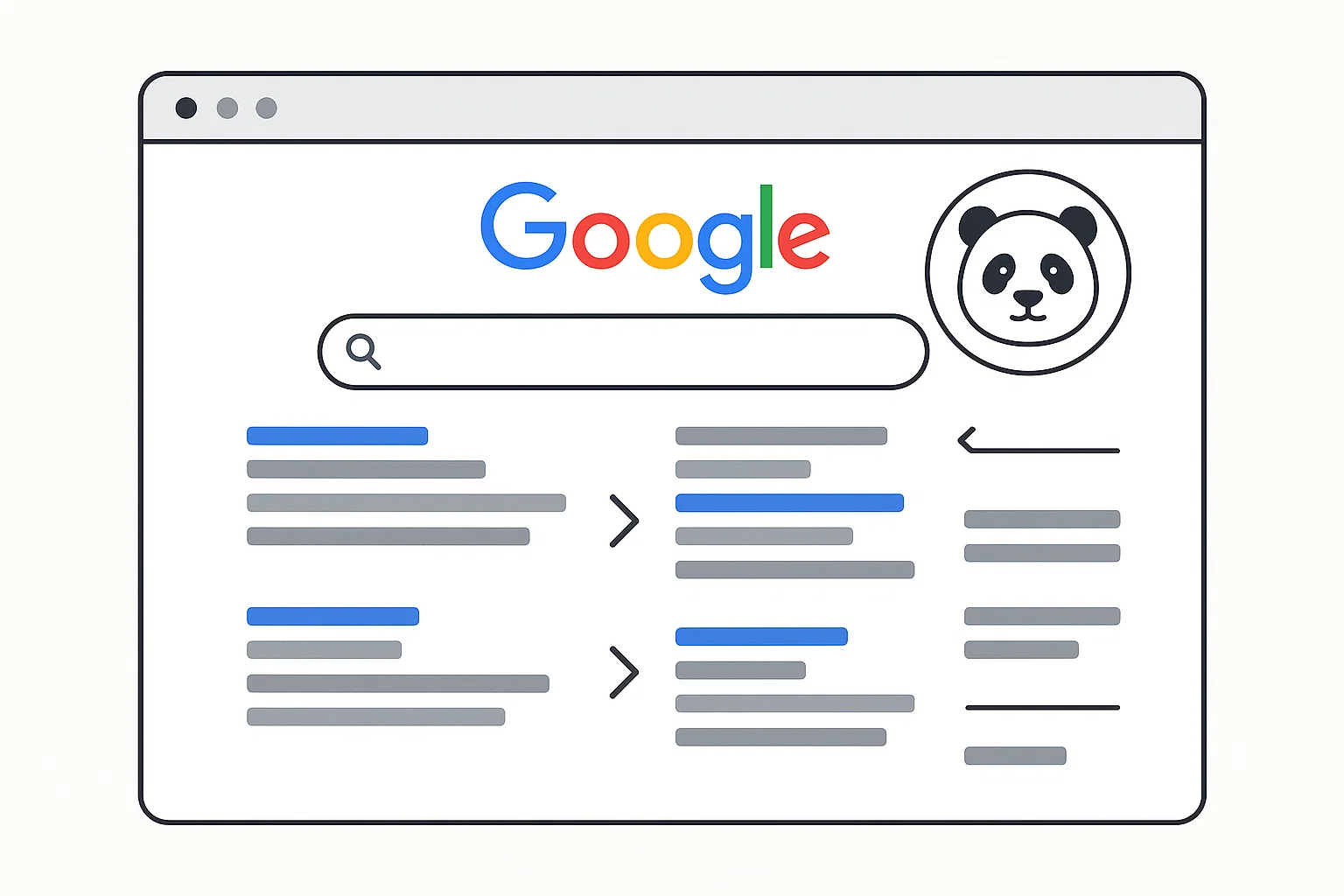
That chaos gave birth to Google Panda Update, one of the most famous and feared algorithm updates ever rolled out. It reshaped SEO, flipped the search results upside down, and taught website owners a brutal lesson: quality content beats quantity, every single time.
Let’s unpack what Panda was, why it mattered, what it penalised, and why its shadow still hangs over SEO in 2025.
What Is the Google Panda Update?
Launched in February 2011, the Panda update was Google’s way of cleaning up its search results. Named after Navneet Panda, the engineer who created the algorithm, this update wasn’t just a tweak, it was a hammer.
Instead of rewarding websites that stuffed in keywords or published thousands of thin pages, Panda aimed to measure content quality signals. The goal? Push high-value content to the top and bury sites that existed purely to manipulate rankings.
Think of it as Google saying: “Stop feeding us garbage. Give users real answers.”
What Was the Main Purpose of the Panda Update?
At its heart, Panda wasn’t about punishing, it was about protecting the user experience. Google realised its reputation was at risk. If users kept seeing spammy pages, they’d start trusting other search engines.
The update focused on three main goals:
Reward trustworthy websites: Blogs, news sites, and authority platforms with strong, original writing.
Clean up thin content: Pages with 200 words of recycled text and no real insight were toast.
Demote content farms: Sites like Demand Media and eHow, which mass-produced low-quality articles, lost millions in traffic overnight.
In short, Panda drew a clear line: write for humans, not just search engines.
What Did Google’s Panda Update Penalise?
Here’s where things got nasty for many webmasters. Panda had a knack for sniffing out sites built on shortcuts. If your site ticked any of these boxes, you were in trouble:
Thin content: Pages with little to no substance.
Duplicate or scraped content: Copying from others or even recycling your own across multiple pages.
Keyword stuffing: Repeating keywords to the point it looked spammy.
Content farms: Mass-producing low-value posts to dominate every keyword variation.
Overloaded ads: Pages where ads outweighed useful information.
Poor UX: Slow loading, clunky design, confusing navigation.
Imagine investing years into growing your site, only to see traffic nosedive overnight because Panda labelled your work as low quality. Brutal, but it also set a new standard.

Impact of Panda on SEO
The Panda update wasn’t just another blip. It shook the foundations of SEO.
Big names suffered. Entire networks lost billions of page views. Demand Media’s stock even tanked after the update. But on the flip side, smaller blogs and authority sites producing genuine, well-researched content suddenly started climbing the rankings.
This update also shifted how SEO professionals thought. The old playbook, spam links, stuff keywords, crank out endless posts, was dead. Panda taught the industry a harsh truth: Google cares about quality, not just numbers.
Over time, Panda wasn’t just an occasional update. By 2016, it became baked into Google’s core algorithm, meaning its effects run constantly in the background even today.
The Panda Trick on Google – Myth or Reality?
If you’ve been in SEO forums, you’ve probably heard people whisper about the so-called “Panda trick.” Some claimed it was a hack to get rankings back or bypass penalties.
Here’s the reality: there’s no magic Panda trick. What people usually mean is making surface-level fixes, like padding thin articles with fluff or hiding duplicate text. But Google’s smarter than that. Panda (and its successors) look at deeper signals: user engagement, originality, trustworthiness.
So the only real “trick” is boring but powerful: write content that deserves to rank.
What Is the Recent Google Update?
Fast forward to 2025, and Panda’s influence hasn’t faded. Instead, it evolved into broader core updates and Helpful Content Updates.
Google now leans heavily on EEAT (Experience, Expertise, Authoritativeness, Trustworthiness) when ranking websites. That means:
Real authors with visible credibility.
In-depth, accurate, and useful articles.
Sites that feel trustworthy, not spammy or anonymous.
So when you hear about recent updates, remember, they’re Panda’s grandkids, carrying forward the same mission: to reward value-driven content.
How to Stay Safe from Panda-Like Penalties Today
Panda may have launched in 2011, but its principles are still the backbone of SEO in 2025. Want to future-proof your site? Follow these guidelines:
Write original content: No rewrites or copy-paste jobs.
Add depth: Instead of 200 words, aim for comprehensive, well-researched guides.
Balance ads with value: Monetisation is fine, but don’t drown readers in banners.
Improve UX: Fast loading, clean design, mobile-friendly layout.
Update old content: Freshness matters. Don’t let your pages rot.
Use tools wisely: An AI Reword Tool or Paraphrasing Tool can help polish and humanise your writing, but make sure the final draft feels natural.
Quick Checklist for Writers and Bloggers
Here’s a handy table to keep your content Panda-proof:
| Do’s | Don’ts |
|---|---|
| Write for humans, not bots | Stuff keywords unnaturally |
| Provide original insights | Copy or spin articles |
| Use clear structure & headings | Dump ads all over the page |
| Update outdated content | Publish thin 200-word posts |
| Check readability | Ignore site speed & design |
Stick to these basics and you’ll be miles ahead of sites still chasing shortcuts.
Conclusion
The Google Panda update was a wake-up call that changed SEO forever. It wiped out entire empires built on fluff, but it also opened the door for real creators to shine.
And here’s the kicker: Panda wasn’t just history, it’s still alive today, embedded in every Google core update. So if you’re building a site in 2025, don’t look for loopholes. Look for ways to add value.
Because at the end of the day, Google’s message hasn’t changed: quality content wins.

Mia Creatives explores the intersection of technology and creativity. Dive into WordPress, SEO, and innovative ways to thrive online.